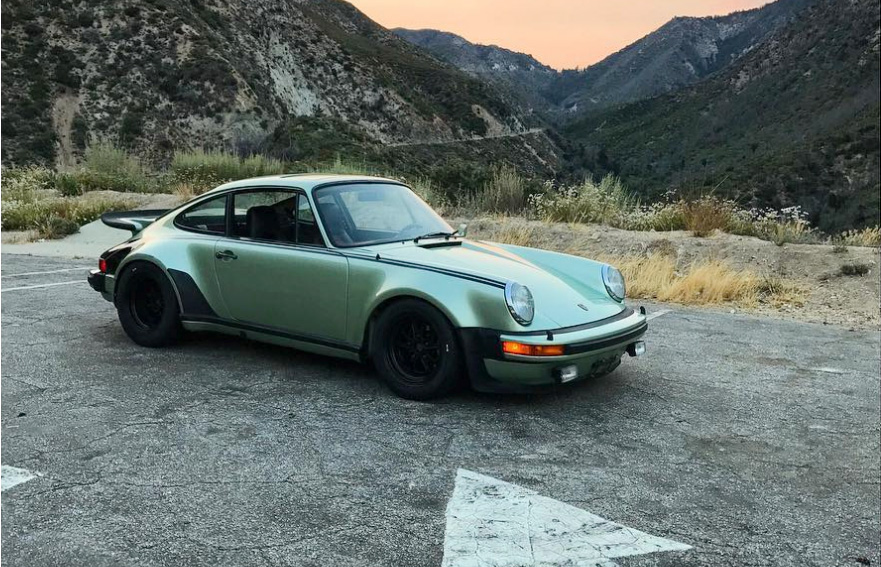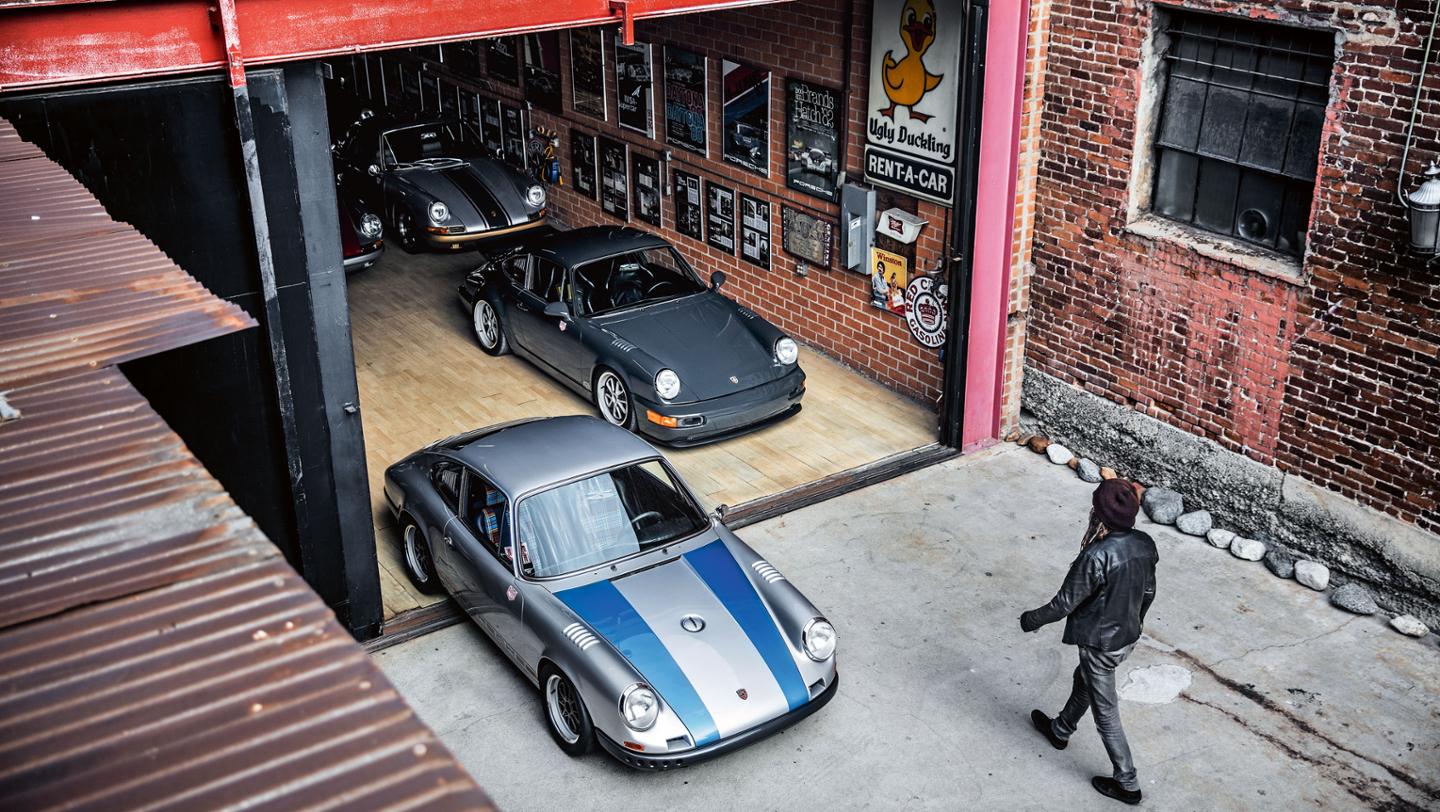
When Magnus Walker looks back on his remarkable life, he’s able to pinpoint the pivotal moments and color them with the detail and context that led him to where he is today. He speaks succinctly and with deliberation, and there’s a sense that not only does he have it all figured out, but that he’s said it before.
He, of course, has. A TED Talk he gave currently has 5.9 million views on YouTube. And when we spoke earlier this week, Walker was preparing to go to Europe for the book tour of his autobiography Urban Outlaw: Dirt Don’t Slow You Down, published last June.
That doesn’t make his arc — from a blue collar steel town in England to Porsche customizer in sun-kissed LA — any less impressive. It just means he’s reached the point in his life when he’s finally had time to stop and think about it.
“When you asked where I see myself in 5,10, 20 years’ time, I kind of laughed internally,” he says. “Because whenever people ask me that question, I don’t have an answer for it. Everywhere I’ve gotten in life has been organically.”
That TED Talk he gave in 2014 was called “Go With Your Gut Feeling,” and it’s a philosophy that he’s applied rigorously to every creative and business decision he’s ever made.

So how did he get here? Well, let’s get to the pivotal moments. Number one, says Walker, would be his choice to start cross country running as a youngster. He got good enough to join one of the running clubs in Sheffield where future gold medalist Sebastian Coe was training. He had the briefest of encounters with Coe upon getting a certificate for a good performance.
“Athletics and cross country is really an individual sport. I think that taught me hard work and dedication,” he says. “At an early age, having a bit of success and support from someone I admired was pivotal.”
But running took a back seat to rock n’ roll and partying in northern England in the early 1980s. He left school at 15 after completing the bare minimum school qualification. He drifted around listlessly, working construction jobs without a clue as to what came next.
Then he heard about a program called Camp America, which offered English teens the opportunity to work as camp counselors in programs for inner-city youth. A year later, in 1986, he went to a camp outside of Detroit where he both experienced culture clash and saw striking similarities between his hometown of Sheffield and the dying former industrial superpower that was Detroit.
When that gig was up, he booked a one-way bus ticket to Los Angeles, where Mötley Crüe and Guns N’ Roses were headlining a thriving rock n’ roll scene. He didn’t have a cent to his name but he had hustle, and when a friend asked if he wanted to earn money selling second-hand clothing on the Venice Beach boardwalk he said yes.
That gig turned into a clothing-customizing business when Walker started sewing patches onto old Levi’s he’d buy at garage sales and second-hand shops. A punk rocker, his aesthetic mirrored the fashion of the times: stonewashed, distressed, and singular.
“My father introduced me to motorsport, but my mother’s side of the family dating back was always market traders,” he says. “That’s where I got the entrepreneurial spirit, from my mother’s side.”
Those first experiments on the Venice boardwalk turned into a brand of clothing called Serious that made the covers of Vogue and Rolling Stone and was worn by the likes of Madonna and Bruce Willis.
“That period of success just fueled more drive, more creativity,” he says. “I didn’t know how I was going to do it, but I’m not going to give up until I do it. I was self taught. I asked a lot of questions and had other people help along the way. And although I had no idea of clothing, I knew what I liked and I knew what style I liked it.”
Then, in 2000, came another pivotal moment.
Tired of paying rent for a loft and a warehouse space in LA’s transient and industrial downtown, he and his wife decided it made more sense to buy. The money he put down as a 33-year-old on the 26,000 square foot warehouse in the wasteland of a location near the picturesque Sixth Street Bridge was more than he had ever imagined he’d spend on something — and he had already begun collecting Porsches. But he also knew that it ultimately made both financial and emotional sense.
“There’s a thread that connects the building, the clothing, and the cars,” he told me. “And that’s doing what you love for the sheer excitement, not because it’ll be worth something some day.”
It didn’t take long for Hollywood to discover the warehouse space as a location. Walker and his wife eventually moved out and managed it as a lucrative filming location full time. Today, of course, it’s worth 15 times what he paid for it. The area of transients and deadbeats is now the hottest neighborhood in LA: an upscale restaurant is next door, a Blue Bottle at the corner.
Walker himself doesn’t spend much time there. You can still spot him walking around when he’s in town — he lives in a condo around the corner — and he’ll pop into the warehouse to work on the Porsches, almost all of which he buys inexpensively and then makes priceless through detailed custom work. But a life of random chance and diligent follow-through has given him what he’s always wanted: freedom.
“I’ve learned to never give up. The TED Talk that came out less than four years ago is the most viewed thing I’ve ever done. Ninety-five percent of the people who saw that talk had no idea who I was or what I did. But for all the emails I get, the most inspiring I get is the ones who watched it, shared a similar passion and have decided ‘If he can do it, so can I.’ ”
Brands like Porsche and Hot Wheels fly him around as an ambassador and a collaborator. He says he’s spent an entire month without house keys in his pocket and now books almost all of his flights one-way. There have been a couple of recent setbacks — he was in a wheelchair for two months after suffering a double stress fracture in his shins at the age of 48 — that have refocused him, and reaching the 50 milestone has provided a natural opportunity for reflection.
“Don’t be too rigid in your thoughts,” he says. “Hence the question, ‘Where do you see yourself in 5, 10, 30 years time?’ I don’t know. For me it’s a mental chapter, it’s the next chapter of my life. The past 30 years of my life happened really quick. Now it’s about different priorities.”

The ideas expressed here are solely the opinions of the author and are not researched or verified by AGEIST LLC, or anyone associated with AGEIST LLC. This material should not be construed as medical advice or recommendation, it is for informational use only. We encourage all readers to discuss with your qualified practitioners the relevance of the application of any of these ideas to your life. The recommendations contained herein are not intended to diagnose, treat, cure or prevent any disease. You should always consult your physician or other qualified health provider before starting any new treatment or stopping any treatment that has been prescribed for you by your physician or other qualified health provider. Please call your doctor or 911 immediately if you think you may have a medical or psychiatric emergency.


